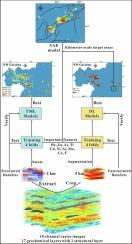Prospectivity mapping and exploration targeting for sediment-hosted Pb–Zn deposits in NW Guizhou of SW China using an integrated machine learning framework
IF 3.6
2区 地球科学
Q1 GEOLOGY
引用次数: 0
Abstract
Northwestern (NW) Guizhou in SW China hosts more than 100 Pb-Zn deposits which are primarily small in scale. In recent years, the discovery of a few large to super-large Pb-Zn deposits has revealed significant mineralization potential. It is thus necessary to reevaluate the mineral prospectivity using advanced predictive methods. This study presents an integrated machine learning framework that combines deep learning (DL), traditional machine learning (TML), and unsupervised deep learning via a variational autoencoder (VAE) for high-precision Pb-Zn prospectivity mapping in NW Guizhou. A total of 135,385 high-density soil geochemical samples (17 elements) with structural datasets are used to establish 18 evidence layers for hierarchical mineral potential assessment. Using four-fold cross-validation, this study shows that both the DL model trained on 5 × 5 km multi-channel image patches and the TML models utilizing 1–2 km buffer-processed numerical data achieved accuracies of 90 % or above on the test set. In practical application, the DL prospectivity map delineated high-confidence prospect areas more precisely than the TML models, suppressed background noise more effectively and captured nearly 90 % of known deposits. Although the TML model shows slightly lower prediction success rates (∼80 %), it provides smoother anomaly transition and identifies local anomalies in the target area. The integration of VAE with mineralization-related elements further enhances the system’s capability, enabling anomaly detection, improving the contrast of target areas, and refining them to kilometer-scale precision. Through the integration of the machine learning methods, this study successfully generates high-precision prospectivity maps and optimizes target areas at a kilometer scale, offering significant insights for sediment-hosted Pb-Zn deposit exploration.

基于集成机器学习框架的贵州西北沉积型铅锌矿远景图及找矿目标
贵州西北地区有100多个规模较小的铅锌矿床。近年来发现的几个大型至超大型铅锌矿床,显示出巨大的成矿潜力。因此,有必要采用先进的预测方法对找矿前景进行重新评价。本研究提出了一个集成的机器学习框架,该框架结合了深度学习(DL)、传统机器学习(TML)和通过变分自编码器(VAE)的无监督深度学习,用于贵州西北部高精度铅锌远景测绘。利用高密度土壤地球化学样品135,385份(17种元素)和构造数据集,建立了18个证据层,进行了分级矿物潜力评价。通过四重交叉验证,本研究表明,在5 × 5 km多通道图像块上训练的深度学习模型和使用1-2 km缓冲处理的数值数据的TML模型在测试集上的准确率均达到90%以上。在实际应用中,DL远景图比TML模型更精确地圈定了高置信度的远景区,更有效地抑制了背景噪声,并捕获了近90%的已知矿床。尽管TML模型的预测成功率略低(约80%),但它提供了更平滑的异常过渡,并识别了目标区域的局部异常。VAE与矿化相关元素的集成进一步增强了系统的能力,实现了异常检测,提高了目标区域的对比度,并将其细化到千米尺度的精度。通过整合机器学习方法,该研究成功生成了高精度的远景图,并在千米尺度上优化了目标区域,为沉积物型铅锌矿床勘探提供了重要的见解。
本文章由计算机程序翻译,如有差异,请以英文原文为准。
求助全文
约1分钟内获得全文
求助全文
来源期刊

Ore Geology Reviews
地学-地质学
CiteScore
6.50
自引率
27.30%
发文量
546
审稿时长
22.9 weeks
期刊介绍:
Ore Geology Reviews aims to familiarize all earth scientists with recent advances in a number of interconnected disciplines related to the study of, and search for, ore deposits. The reviews range from brief to longer contributions, but the journal preferentially publishes manuscripts that fill the niche between the commonly shorter journal articles and the comprehensive book coverages, and thus has a special appeal to many authors and readers.
 求助内容:
求助内容: 应助结果提醒方式:
应助结果提醒方式:


